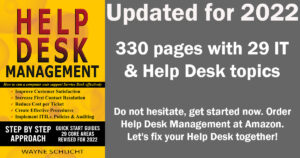
Getting Help Desk Management right is a rewarding journey. At BuildaHelpDesk.com, we are promoting solid Help Desk management best practices on how to set up a help desk. These best practices are based on industry-standard IT service management processes, which are critical for an efficient, well-performing, and customer-focused Help Desk. Because of that, your challenge as a Help Desk Manager is to identify those industry standards, such as ITIL, and learn how to introduce them to your team. Below are some key topics on how to run a successful help desk.
Help Desk Management Policies

To meet or exceed expectations, Help Desk Management staff know that they have well-thought-out job-related policies. Therefore, it is important to implement fair and consistent policies related to time away, disciplinary, and grievance issues. Most importantly, clear direction creates an environment where employees are engaged and happy. In addition, it provides a Help Desk Management structure on how to appropriately manage fairly. Learn how to improve help desk support. To be effective in IT support leadership positions, there are many policy fundamentals you should be aware of.
- Accessible – The policies must be accessible to the employees. Store policies on a read-only website, SharePoint page or other electronic repositories that allows access at any time.
- Training – Employees should receive specific policy training and be able to ask questions and for clarifications. To successfully enforce the policies, employees must understand the policies. An annual review of departmental policies is critical to remind employees of the department’s expectations.
- Employee acknowledgment – Once the employee receives training and has all their questions answered, they should sign a statement agreeing to comply with the policies.
Help Desk Management Customer Service
Your Help Desk Management team should understand customers are the company’s lifeblood. Understanding your customers’ most frequently occurring questions and issues will help you improve the customer experience. Therefore a happy customer is a repeat customer. A repeat customer will provide word-of-mouth advertising to develop organic new customers for very little cost. If your customers are internal, this also applies. Positive interaction with your internal customers will improve customer satisfaction survey results and increase customer productivity. Never treat internal or external customers poorly to avoid negative consequences.
Understand your team
One of the biggest challenges for a new Help Desk Manager is understanding their team. While it is important to understand the personalities of the individuals working on your team, I stress understanding your team in the sense of structure and processes. This is an important factor in how to build a successful service desk team. Of course, every company has unique organizational structures, job descriptions, use of specialists, and staff-to-management ratios. If you recognize and study the efficiencies of these structures and processes, you can make informed decisions for improvements. Furthermore, positive improvements will increase productivity, reduce costs and improve the overall work-life balance.
Job Descriptions
One of the best ways to understand the current expectations of your staff is to review their role job descriptions. A well-defined job description is critical to define the primary functions and duties of the position. First, you should determine if there is one general job description or multiple job descriptions based on experience and special skills. Just having one general job description for the entire Help Desk staff will not promote a career path. It means as Help Desk agents season and mature in their position, they will not have the opportunity for an internal position within the team.
In a mature Help Desk structure, you will see job positions have a level 1, 2, and 3 tier level experience modifier or you may have a junior and senior level. Level 1 or junior positions will perform routine duties under direct supervision. Level 2, 3, and senior positions will handle more complex issues, be an internal escalation point, and guide the junior staff.
Employee Training and Development
Managers know that company success results from knowledgeable and engaged workers with the skills to meet their job duties. You need a comprehensive training and development program to develop and keep top talent productive. Employee training is to improve workers’
performance by transferring skill-based knowledge to be used in their current job position. Employee development is to advance an employee’s skills and knowledge beyond what is required for their current job position.
If you manage a support team such as a Help Desk or call center, you know that your customers expect correct answers quickly. They also demand a level of customer service that meets or exceeds their expectations. Of course, good employee training and development programs don’t just happen. Below are some examples of training and development programs on improving help desk support.
Examples of Training and Development programs
- Curriculum – The curriculum includes teaching aids, handbooks, visual aids, webinars, and computer tutorials.
- New Hire Onboarding – Proper onboarding will affect their initial engagement, and integration, and set positive expectations for their new positions.
- Ongoing training and skill development – An ongoing training program is important for employees to refresh their current required knowledge of work practices and assist employees in incrementally improving their skills. Companies will use ongoing training to keep up with industry changes and the latest technology to stay ahead of competitors. An example of ongoing training could be a ticket queue management process refresher.
- New process training – Implement new process and application training. Identify changes, implementation timing, expectations, and where to go for additional assistance.
- Just in time / CBT training – Just in time and CBT training is a good option to provide on-the-spot training when an employee is confronted with the new application or process. This training could be provided by an in-person visit by a trainer, a computer-based training video or a quick reference card at the employee’s work location.
Quality Assurance Program
As a good Help Desk Manager, in addition to establishing customer contact handling procedures and providing your staff with good customer service training, you must audit their performance. Therefore Help Desk management team must implement a quality assurance audit. This audit is a program to review calls and tickets regularly using a standard methodology.
Benefits of implementing a Help Desk audit program.
- Incentive and bonus programs – Audit data can be used to validate Help Desk agent performance and reward positive behavior.
- Performance Management – Audit data can assist managers in having meaningful weekly and monthly performance review sessions with the team and individuals.
- Annual reviews – Help Desk activities can be easily tracked with audit data metrics. Metrics are used to ensure Help Desk Agents meet or exceed mid and annual review objectives.
- Training – Audit data can be analyzed to identify negative trends quickly. Once spotted, a manager can intervene with proper coaching and training as needed.
- Inappropriate behavior – By regularly auditing agents’ calls and their internal ticketing system tickets, you can uncover and correct inappropriate behavior before it causes serious damage to your company’s brand.
Understand the Business
Help Desk managers focus staff on providing customer and business support. What if your Help Desk management team has limited resources? How do you appropriately allocate support? Immature Help Desk will approach this with a first in, first out, or whoever screams the loudest approach. While this may have limited success, we need to start thinking about how to prioritize issues. Prioritize incident tickets based on impact and urgency. The incident impact is the potential financial, brand, or security damage caused by the incident on the business organization before it can be resolved. Urgency is how quickly incident resolution is required.
By knowing your company’s business, products, and applications, you can prioritize incidents. Equally important is that the Help Desk understands the business and what services are mission-critical. Services deemed mission-critical are the highest priority services. Your department needs specialists and ideal help desk policies to support them. Meeting with department leaders and staff regularly is very important to understand what is most important for each department to run its business. One department’s mission-critical services can be from another department.
Market the Help Desk
Help Desk services consumed add value. Therefore customers of your Help Desk need to know what services are available and how to request them. These services include computer system repair, application support, and access request management to controlled resources. Help Desk services are an expense, but successful Help Desk managers will market them anyway. Customers that are aware of what services are available are more likely to have higher satisfaction with the technology they use for their job function. Comparatively, marketing Help Desk services to internal customers are like general public marketing campaigns you may be familiar with.
Help Desk Marketing Examples
- Welcome Guide – First impressions are long-lasting. It is important to provide new company employees with a welcome guide, outlining company services available, contact channels, hours of operation, URLs of the support portal, and such.
- Quick Reference Guides – Providing quick reference cards in a welcome guide, online, or as a handout will greatly improve user productivity and reduce calls to the Help Desk.
- Help Desk website/portal – Implement a Help Desk online customer portal to inform customers and increase productivity. A typical Help Desk portal lets customers request help via a support ticket, check the status of a current support ticket, or search through previous tickets.
- Informational tours – Meet with departments to present and answer questions
- Brown Bag Sessions – Deliver a topic-focused meeting during lunch to inform customers.
- Technology Fairs – It is an opportunity for the Information Technology department to display the systems used, services available, and staff. In light of that fact having the Help Desk at the technology fair is a great way to market the Help Desk services.
Perform a Maturity Assessment
For an organization initially setting up their Help Desk management practices, there is a lot of industry-standard IT Service Management and ITIL information available to build a strong foundation. Of course, an established Help Desk will need to understand how they are doing and what needs attention for improvement. In the IT Service Management community, we start by using something called a maturity assessment. Complete a maturity assessment to determine maturity compared to industry standards. It is important to note that the value realized from an assessment is directly related to the thoroughness of the assessment data gathered, including staff interviews. There are many benefits in performing a maturity assessment.
Management and ITIL information available to build a strong foundation. Of course, an established Help Desk will need to understand how they are doing and what needs attention for improvement. In the IT Service Management community, we start by using something called a maturity assessment. Complete a maturity assessment to determine maturity compared to industry standards. It is important to note that the value realized from an assessment is directly related to the thoroughness of the assessment data gathered, including staff interviews. There are many benefits in performing a maturity assessment.
Help Desk Management Certification
Many companies will recognize 3rd party certification for Help Desk management in hiring a new manager. One of the most respected Help Desk manager certifications is from HDI. This certification has a description from HDI which states “that the support center manager possesses the knowledge of best and common practices necessary to successfully manage the operational and tactical components of a support organization while strategically aligning with the needs of the business.” In addition, you should also consider sending your ticketing application administrators to vendor training classes. Whether you use Freshdesk, Zendesk or another ticketing application, all vendors should offer administrator training classes.
10 Help Desk Management Best Practices
- Implement fair and consistent policies
- Provide great customer service
- Understand your team’s dynamics
- Use effective and accurate job descriptions
- Invest in employee training and development
- Establish an agent quality assurance program
- Understand the business
- Market the Help Desk
- Perform a maturity assessment
- Support Help Desk Management certifications
Additional Help Desk Management information
Wayne Schlicht is the author of Help Desk Management: How to run a computer user support Service Desk effectively.
Instead of just providing you with a lot of technical information, this book will empower you with a step-by-step approach to mature your Help Desk. Each chapter includes straightforward processes that are easy to understand. Once you completely understand the process, chapters are concluded with a quick start implementation worksheet to implement your new process. This format will allow you to rapidly transform your people, processes, and technology into a customer-focused center of excellence today!
Leave a Reply